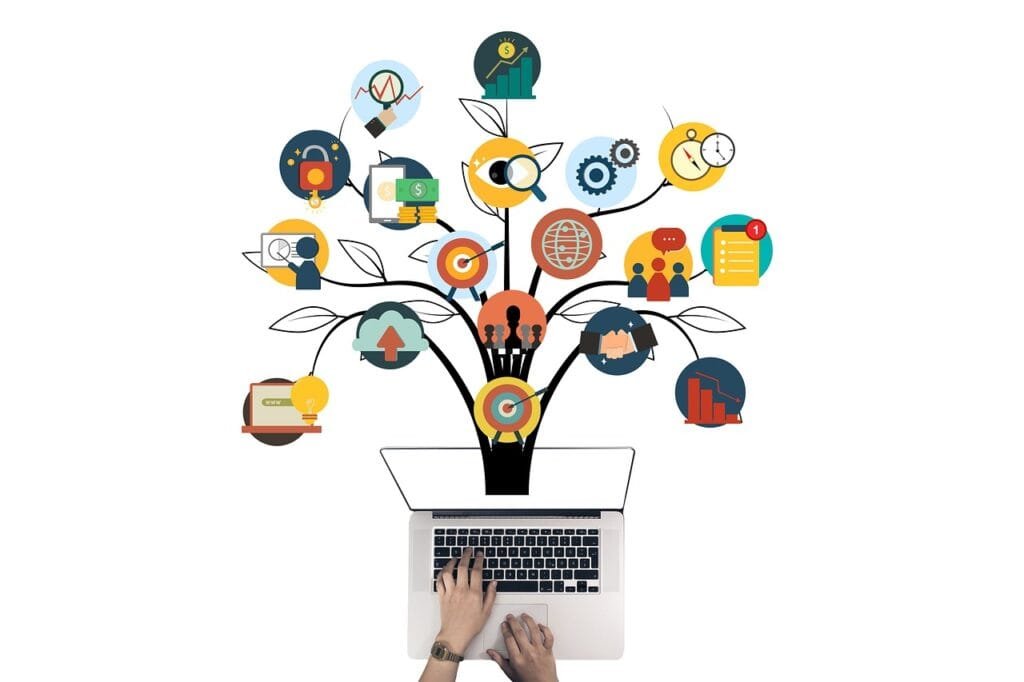This Article has been revised, edited and added to, by Poulomi Chakraborty.
- Traditional Marketing in E-learning
- Understanding Your Audience
- Developing Engaging Content for E-learning Platforms
- Promoting Your E-learning Content
- Building a Community of Engaged Learners
- Creating a Supportive Learning Environment
- Facilitating Peer-to-Peer Interaction
- Hosting Live Events and Webinars
- Encouraging User-Generated Content
- Leveraging Social Media for Community Building
- Providing Continuous Engagement
- Gathering and Acting on Feedback
- Showcasing Success Stories
- Measuring Community Engagement
- Measuring the Impact of Your Content Marketing Strategy
- Conclusion
In the digital age, e-learning platforms have revolutionized education, making learning accessible to anyone with an internet connection. However, with the increasing number of e-learning options available, engaging learners effectively has become a significant challenge. This is where content marketing comes into play. By creating and sharing valuable, relevant, and consistent content, e-learning platforms can attract and retain learners, fostering a more engaging learning experience.
Content marketing is not just about creating content; it’s about creating the right content. This involves understanding your audience, knowing their needs, and delivering content that resonates with them. For e-learning platforms, this means creating content that not only educates but also engages and motivates learners to continue their learning journey.
To appreciate the importance of content marketing in e-learning, it’s helpful to compare it with traditional marketing approaches. Traditional marketing often focuses on direct promotion and advertising, aiming to attract learners through flashy advertisements and promotional materials. While this can generate initial interest, it often falls short in terms of long-term engagement and retention. On the other hand, content marketing takes a more subtle and sustainable approach, focusing on building relationships with learners by providing value through content.
Traditional Marketing in E-learning

Traditional marketing for e-learning platforms typically involves tactics such as paid advertising, direct mail, and promotional events. These methods aim to create immediate awareness and drive quick enrollments. However, this approach often results in a transactional relationship with learners, where the primary focus is on acquiring new students rather than engaging and retaining them.
One of the key drawbacks of traditional marketing is that it often interrupts the learner’s journey. For instance, a pop-up ad might catch the learner’s attention momentarily, but it can also disrupt their experience, leading to frustration. Moreover, traditional marketing tends to be one-size-fits-all, failing to address the unique needs and preferences of individual learners.
Another limitation of traditional marketing is its short-term focus. Once the initial campaign is over, the connection with potential learners often ends, resulting in a lack of sustained engagement. This can be particularly problematic for e-learning platforms, where ongoing learner engagement is crucial for success.
Content Marketing in E-learning
In contrast, content marketing takes a more learner-centric approach. It focuses on creating valuable content that attracts, engages, and retains learners over the long term. By providing useful and relevant information, e-learning platforms can build trust and credibility with their audience, fostering a deeper connection.
Content marketing allows for personalization, which is a significant advantage over traditional marketing. By understanding the specific needs and preferences of their audience, e-learning platforms can create tailored content that resonates with individual learners. This personalized approach not only enhances the learning experience but also increases the likelihood of long-term engagement.
Another key benefit of content marketing is its ability to create a continuous learning journey. Instead of a one-time interaction, content marketing fosters an ongoing relationship with learners. Through regular blog posts, videos, webinars, and other content forms, e-learning platforms can keep learners engaged and motivated to continue their education.
Moreover, content marketing is inherently non-intrusive. Instead of interrupting the learner’s experience with ads, it integrates seamlessly into their learning journey. For example, a well-timed blog post or tutorial can provide valuable insights just when the learner needs it, enhancing their overall experience.
Comparing Traditional and Content Marketing
To better understand the differences between traditional and content marketing, let’s consider a hypothetical e-learning platform, LearnPro.
In a traditional marketing approach, LearnPro might run a series of paid ads on social media, highlighting their courses and special offers. While this can attract a lot of attention and drive initial enrollments, the engagement tends to drop off once the campaign ends. Learners might enroll based on the promotional material but may not feel a lasting connection to the platform.
On the other hand, if LearnPro adopts a content marketing strategy, they would focus on creating valuable content that addresses the needs and interests of their target audience. This might include blog posts on learning strategies, video tutorials on course topics, and webinars featuring industry experts. By consistently providing valuable content, LearnPro can build a loyal community of learners who feel connected to the platform and are more likely to stay engaged over the long term.
In summary, while traditional marketing can generate quick wins, content marketing offers a more sustainable and effective approach for engaging learners in the e-learning space. By focusing on creating valuable, relevant content, e-learning platforms can build lasting relationships with their audience, enhancing learner engagement and retention.
Understanding Your Audience

To engage learners effectively through content marketing, it’s essential to understand your audience deeply. Knowing who your learners are, what they need, and how they prefer to consume content will guide you in creating content that resonates with them. This involves segmenting your audience, creating learner personas, and gathering insights into their preferences and behaviors.
Segmenting Your Audience
Audience segmentation involves dividing your learners into distinct groups based on specific criteria such as demographics, learning goals, interests, and behavior patterns. This helps you tailor your content to meet the unique needs of each segment, enhancing relevance and engagement.
For instance, an e-learning platform offering courses in various subjects like technology, business, and arts can segment its audience based on their preferred subjects. Additionally, you might segment learners based on their experience levels, such as beginners, intermediate learners, and advanced learners. By understanding these segments, you can create targeted content that addresses the specific needs and challenges of each group.
Creating Learner Personas
Learner personas are fictional representations of your ideal learners. They are created based on real data about your audience, including their demographics, motivations, goals, challenges, and preferences. Creating learner personas helps you understand your audience better and tailor your content to meet their needs more effectively.
For example, a learner persona for an e-learning platform offering coding courses might be “Techie Tom,” a 25-year-old software engineer looking to upskill in machine learning. Techie Tom prefers video tutorials and hands-on projects, values practical knowledge, and seeks career advancement opportunities. Another persona might be “Career Changer Carol,” a 35-year-old marketing professional looking to transition into data science. Carol prefers structured courses with certification, enjoys interactive quizzes, and needs content that fits her busy schedule.
By creating detailed learner personas, you can ensure that your content speaks directly to the needs and preferences of your target audience, making it more engaging and relevant.
Gathering Insights into Learner Preferences
To create content that truly engages learners, you need to gather insights into their preferences and behaviors. This involves using data analytics, surveys, and feedback to understand how learners interact with your content and what they find most valuable.
Analytics tools can provide valuable data on learner behavior, such as which content formats are most popular, which topics generate the most engagement, and how learners progress through courses. For instance, you might discover that video tutorials have higher completion rates than text-based modules, or that learners spend more time on interactive quizzes compared to reading materials.
Surveys and feedback forms are also valuable tools for gathering insights directly from your learners. You can ask learners about their content preferences, challenges they face, and suggestions for improvement. This feedback helps you understand their needs better and make data-driven decisions to enhance your content strategy.
Personalizing the Learning Experience
Personalization is key to engaging learners effectively. By leveraging the insights gained from audience segmentation, learner personas, and data analytics, you can create personalized learning experiences that cater to the unique needs of each learner.
Personalized content can take various forms, such as tailored course recommendations, customized learning paths, and personalized feedback. For example, if a learner shows a strong interest in data science, you can recommend advanced courses in that field, provide personalized study plans, and offer feedback based on their progress.
Personalization not only enhances the relevance of your content but also makes learners feel valued and understood. This fosters a deeper connection with your platform, increasing engagement and retention.
The Role of Content Formats in Engagement
Different learners have different preferences when it comes to content formats. Some might prefer video tutorials, while others might enjoy interactive quizzes or reading materials. To engage learners effectively, it’s important to offer a variety of content formats that cater to different learning styles and preferences.
Video Tutorials
Video tutorials are highly effective for engaging learners, especially for complex topics that require visual explanations. They can include step-by-step demonstrations, animations, and real-world examples, making learning more interactive and engaging. For example, a coding course might include video tutorials that demonstrate how to write and debug code, providing learners with a clear visual guide.
Interactive Quizzes
Interactive quizzes are another powerful content format for engaging learners. They provide immediate feedback, allowing learners to assess their understanding and identify areas for improvement. Quizzes can be used at various points in a course to reinforce learning, test knowledge, and keep learners engaged.
Infographics and Visual Aids
Infographics and visual aids are effective for presenting complex information in a simple and visually appealing way. They can be used to summarize key concepts, illustrate processes, and highlight important data. For example, an infographic on the steps of a scientific experiment can help learners grasp the sequence and purpose of each step more easily.
Articles and Blog Posts
Articles and blog posts are valuable for providing in-depth information and insights on specific topics. They allow for detailed explanations and can include references to additional resources. Blog posts can also be used to share success stories, expert interviews, and industry trends, providing learners with valuable knowledge and inspiration.
Webinars and Live Sessions
Webinars and live sessions offer a real-time interactive learning experience. They allow learners to engage with instructors, ask questions, and participate in discussions. Webinars can be used to cover advanced topics, host guest speakers, and provide hands-on demonstrations. The live interaction adds a personal touch, making learners feel more connected and engaged.
Developing Engaging Content for E-learning Platforms

Creating engaging content for e-learning platforms involves more than just delivering information. It’s about crafting an experience that captivates learners, motivates them to continue, and helps them achieve their learning goals. This requires a combination of creativity, strategic planning, and a deep understanding of your audience’s needs and preferences.
Crafting Compelling Narratives
One of the most effective ways to engage learners is through storytelling. Compelling narratives can make complex topics more relatable and memorable. By framing your content around a story, you can capture learners’ attention and keep them engaged.
For instance, instead of simply presenting facts and figures about climate change, you could tell the story of a community affected by it. This humanizes the issue, making it more impactful and easier to understand. Stories can also provide context, showing how the information applies to real-world scenarios, which helps learners see the relevance and importance of the content.
Incorporating Interactive Elements
Interactive elements are key to keeping learners engaged. They encourage active participation, making the learning process more dynamic and enjoyable. Interactive content can include quizzes, simulations, games, and interactive videos.
Quizzes, for example, can be used to reinforce learning and test understanding. After covering a topic, a quiz can help learners review and consolidate their knowledge. Simulations and games can provide hands-on experience in a safe and controlled environment. For example, a medical e-learning platform might use simulations to allow learners to practice surgical procedures.
Interactive videos can include clickable elements, allowing learners to choose their path through the content. This not only makes the learning experience more engaging but also caters to different learning preferences.
Utilizing Multimedia Content
Multimedia content, such as videos, infographics, and audio, can enhance the learning experience by catering to different learning styles. Some learners might prefer watching a video, while others might benefit more from visual aids like infographics or listening to an audio recording.
Videos are particularly effective for explaining complex concepts and demonstrating processes. They can include animations, interviews, and real-world examples, making the content more engaging and easier to understand. Infographics can simplify complex information into visual formats, making it more digestible. Audio content, such as podcasts, allows learners to engage with the material while on the go.
Designing Visually Appealing Content
The visual design of your content plays a crucial role in engagement. Well-designed content can capture attention, improve comprehension, and make the learning experience more enjoyable. This involves using a clean and intuitive layout, incorporating visuals, and ensuring consistency in design elements.
For instance, using high-quality images and graphics can make your content more visually appealing. Consistent use of colors, fonts, and branding elements helps create a cohesive look and feel. It’s also important to ensure that the design is user-friendly, with clear navigation and easy-to-read text.
Providing Real-World Applications
Learners are more likely to engage with content that they find relevant and applicable to their lives or careers. Providing real-world applications of the concepts being taught helps learners see the value of the content and how it can be applied in practical scenarios.
For example, a course on digital marketing might include case studies of successful campaigns, showing how the concepts were applied in real-world situations. Providing practical exercises and projects that allow learners to apply what they’ve learned can also enhance engagement. This hands-on approach helps learners retain information better and see the direct benefits of their learning.
Ensuring Accessibility
Accessibility is an important aspect of engaging learners effectively. Ensuring that your content is accessible to all learners, including those with disabilities, is crucial for creating an inclusive learning environment. This involves following accessibility guidelines and standards, such as providing alternative text for images, ensuring content is navigable by keyboard, and using captions for videos.
Encouraging Collaboration and Community
Creating a sense of community among learners can significantly enhance engagement. Encouraging collaboration and interaction helps learners feel connected and supported. This can be achieved through discussion forums, group projects, and social learning platforms.
Discussion forums allow learners to ask questions, share insights, and engage in discussions with their peers and instructors. Group projects provide opportunities for collaborative learning, where learners can work together to solve problems and complete tasks. Social learning platforms can facilitate interactions and build a sense of community, making the learning experience more social and engaging.
Offering Continuous Support and Feedback
Providing continuous support and feedback is essential for keeping learners engaged. Regular feedback helps learners understand their progress, identify areas for improvement, and stay motivated. This can be achieved through quizzes, assignments, and personalized feedback from instructors.
Offering support through various channels, such as email, chat, and forums, ensures that learners can get help when they need it. This support network helps learners feel more confident and encourages them to continue their learning journey.
Promoting Your E-learning Content

Creating engaging content is only part of the equation. To reach and engage your target audience, you need to effectively promote your e-learning content. This involves leveraging various marketing channels and strategies to increase visibility, attract learners, and drive engagement.
Leveraging SEO for E-learning
Search engine optimization (SEO) is crucial for increasing the visibility of your e-learning content. By optimizing your content for search engines, you can attract organic traffic from learners searching for relevant topics.
This involves conducting keyword research to identify the terms and phrases your target audience is using. Incorporate these keywords into your content, including titles, headings, and body text. Ensure your content is well-structured, with clear headings and subheadings, and use meta tags and descriptions to improve search engine rankings.
Creating high-quality, informative content that addresses the needs of your audience can also improve your SEO. Search engines prioritize content that provides value to users, so focus on creating comprehensive and engaging content that answers common questions and solves problems.
Utilizing Social Media
Social media platforms offer a powerful way to promote your e-learning content and engage with your audience. By sharing your content on platforms like Facebook, Twitter, LinkedIn, and Instagram, you can reach a wider audience and drive traffic to your e-learning platform.
Create engaging social media posts that highlight the value of your content, using visuals, hashtags, and compelling captions to attract attention. Engage with your audience by responding to comments, participating in discussions, and sharing user-generated content. Social media ads can also be used to target specific demographics and drive traffic to your courses.
Email Marketing
Email marketing is an effective way to reach and engage your audience with your e-learning content. By building an email list, you can keep learners informed about new courses, updates, and promotions. Send regular newsletters that include valuable content, such as blog posts, videos, and tips, to keep your audience engaged.
Personalize your emails based on the interests and preferences of your subscribers. For example, if a learner has shown interest in a particular topic, send them related content and course recommendations. Use compelling subject lines and clear calls-to-action to encourage learners to engage with your content.
Content Partnerships and Collaborations
Partnering with other content creators, influencers, and industry experts can help you reach a broader audience and enhance the credibility of your e-learning platform. Collaborate on content such as guest blog posts, webinars, and video interviews to provide valuable insights and attract new learners.
For example, partnering with an industry expert to co-host a webinar on a trending topic can attract a large audience and position your platform as a trusted source of knowledge. Guest blog posts from influencers can also drive traffic to your site and increase your visibility.
Paid Advertising
Paid advertising can be a powerful tool for promoting your e-learning content and attracting learners. Use platforms like Google Ads, Facebook Ads, and LinkedIn Ads to target specific demographics and drive traffic to your courses.
Create compelling ad copy and visuals that highlight the benefits of your courses and include clear calls-to-action. Monitor the performance of your ads and adjust your strategy based on the results to ensure you are reaching your target audience effectively.
Measuring and Analyzing Performance
To ensure the effectiveness of your content marketing efforts, it’s essential to measure and analyze the performance of your campaigns. Use analytics tools to track key metrics such as website traffic, engagement rates, and conversions.
Analyze the data to understand what’s working and what’s not, and make data-driven adjustments to your strategy. For example, if you notice that video content generates higher engagement than blog posts, you might focus more on creating videos. Regularly reviewing and optimizing your content marketing strategy ensures that you continue to engage learners effectively and achieve your goals.

Building a Community of Engaged Learners
Creating engaging content and promoting it effectively are crucial steps in your content marketing strategy. However, to sustain engagement and foster a sense of belonging among learners, it’s essential to build a community around your e-learning platform. A strong community not only enhances learner retention but also encourages active participation and peer-to-peer learning.
Creating a Supportive Learning Environment
A supportive learning environment encourages learners to participate actively and engage with the content and each other. This can be achieved by fostering a positive and inclusive culture within your community. Encourage learners to share their thoughts, ask questions, and provide feedback without fear of judgment.
One way to create a supportive environment is by having dedicated moderators who facilitate discussions, answer questions, and ensure that interactions remain respectful and productive. Moderators can also highlight valuable contributions from learners, boosting their confidence and encouraging further participation.
Facilitating Peer-to-Peer Interaction
Peer-to-peer interaction is a powerful tool for enhancing engagement and learning. By enabling learners to collaborate and support each other, you create a dynamic learning environment where knowledge is shared, and relationships are built.
Discussion forums and social learning platforms are effective tools for facilitating peer-to-peer interaction. These platforms allow learners to engage in discussions, share resources, and collaborate on projects. Group activities and assignments can also encourage collaboration and foster a sense of community.
For example, a project-based learning activity where learners work together to solve a real-world problem can enhance engagement and provide valuable hands-on experience. Peer reviews and feedback sessions can also help learners improve their work and learn from each other’s perspectives.
Hosting Live Events and Webinars
Live events and webinars are excellent ways to engage learners and build a sense of community. These events provide opportunities for real-time interaction, allowing learners to connect with instructors and peers in a more personal and engaging way.
Hosting regular webinars on relevant topics can attract a large audience and provide valuable insights. Live Q&A sessions, guest speaker events, and panel discussions can also enhance engagement and provide diverse perspectives.
To maximize the impact of live events, promote them in advance through email, social media, and your e-learning platform. Encourage learners to participate actively by asking questions, sharing their thoughts, and engaging in discussions. Recording the events and making them available on-demand can also extend their reach and value.
Encouraging User-Generated Content
User-generated content (UGC) is a powerful way to engage learners and build a sense of community. Encouraging learners to create and share their own content, such as blog posts, videos, and presentations, allows them to contribute to the learning environment and showcase their knowledge.
You can incentivize UGC by hosting contests, challenges, and recognition programs. For example, you might run a contest where learners submit video tutorials on a specific topic, with the best submissions being featured on your platform and rewarded with prizes.
Highlighting user-generated content in newsletters, social media, and your e-learning platform not only recognizes and rewards learners but also inspires others to contribute. This collaborative approach fosters a sense of ownership and pride among learners, enhancing engagement and retention.
Leveraging Social Media for Community Building
Social media platforms offer powerful tools for building and nurturing a community of engaged learners. By creating dedicated social media groups, you can facilitate interactions and discussions among learners outside of your e-learning platform.
Facebook Groups, LinkedIn Groups, and other social media communities provide spaces for learners to connect, share resources, and support each other. These groups can be used to share updates, announce events, and gather feedback from learners.
Active participation from instructors and moderators in these groups can enhance their value, providing additional support and guidance to learners. Encouraging learners to share their successes, challenges, and experiences can also foster a sense of camaraderie and belonging.
Providing Continuous Engagement
Continuous engagement is key to retaining learners and maintaining their interest in your e-learning platform. This involves regularly updating your content, offering new courses, and providing ongoing support and resources.
Regularly publishing blog posts, videos, and other content keeps learners engaged and provides fresh insights and knowledge. Offering new courses and updates to existing courses ensures that learners have access to the latest information and skills.
Providing ongoing support through email, chat, and discussion forums helps learners overcome challenges and stay motivated. Personalized recommendations based on learners’ interests and progress can also enhance engagement by offering relevant and timely content.
Gathering and Acting on Feedback
Feedback is essential for understanding the needs and preferences of your learners and improving your content and community. Regularly gathering feedback through surveys, polls, and discussions provides valuable insights into what’s working and what needs improvement.
Acting on feedback shows learners that their opinions are valued and taken seriously. This can enhance their sense of belonging and encourage further engagement. For example, if learners suggest additional resources or changes to the course structure, implementing these suggestions can improve the learning experience and satisfaction.
Showcasing Success Stories
Showcasing success stories of learners who have achieved their goals through your e-learning platform can inspire and motivate others. Highlighting these stories in newsletters, blog posts, and social media provides real-world examples of the value of your courses.
Success stories can include testimonials, case studies, and interviews with learners. Sharing these stories not only recognizes the achievements of your learners but also builds credibility and trust in your e-learning platform.
Measuring Community Engagement
To ensure the effectiveness of your community-building efforts, it’s important to measure engagement and participation. Use analytics tools to track metrics such as the number of active users, participation in discussions, attendance at live events, and contributions of user-generated content.
Analyzing these metrics helps you understand the level of engagement and identify areas for improvement. For example, if participation in discussion forums is low, you might need to increase moderation and facilitate more discussions. Regularly reviewing and optimizing your community-building strategy ensures that you continue to foster an engaged and active learning community.
Measuring the Impact of Your Content Marketing Strategy

Measuring the impact of your content marketing strategy is crucial to understanding its effectiveness and making data-driven decisions. By tracking key metrics and analyzing the results, you can identify what’s working, what’s not, and where there’s room for improvement. This continuous evaluation helps you refine your strategy to better engage learners and achieve your goals.
Key Metrics to Track
Identifying the right metrics is the first step in measuring the impact of your content marketing strategy. The metrics you choose should align with your objectives and provide insights into the effectiveness of your content.
Engagement Metrics
Engagement metrics help you understand how learners interact with your content. These include:
- Page Views: The number of times a page on your e-learning platform is viewed.
- Time on Page: The average amount of time learners spend on a page.
- Bounce Rate: The percentage of visitors who leave your site after viewing only one page.
- Social Shares: The number of times your content is shared on social media.
- Comments and Interactions: The level of participation in discussions, forums, and comments sections.
Conversion Metrics
Conversion metrics measure how well your content drives desired actions, such as course enrollments and completions. These include:
- Conversion Rate: The percentage of visitors who take a desired action, such as signing up for a course.
- Enrollment Rate: The number of learners who enroll in a course after engaging with your content.
- Course Completion Rate: The percentage of learners who complete a course they enrolled in.
- Lead Generation: The number of leads generated through content marketing efforts, such as downloads of free resources or webinar registrations.
Retention Metrics
Retention metrics help you understand how well your content keeps learners engaged over time. These include:
- Return Visits: The number of times learners return to your platform.
- Active Users: The number of users who regularly engage with your content.
- Churn Rate: The percentage of learners who stop engaging with your content over a specific period.
Tools for Measuring Performance
Various tools can help you track and analyze the performance of your content marketing strategy. These tools provide valuable data and insights to guide your decision-making.
Google Analytics
Google Analytics is a powerful tool for tracking website performance and user behavior. It provides data on page views, time on page, bounce rates, and more. By setting up goals and conversion tracking, you can also measure how well your content drives desired actions.
Social Media Analytics
Social media platforms offer built-in analytics tools, such as Facebook Insights, Twitter Analytics, and LinkedIn Analytics. These tools provide data on engagement rates, reach, impressions, and social shares. Analyzing this data helps you understand how your content performs on social media and identify opportunities for improvement.
Email Marketing Analytics
Email marketing platforms, such as Mailchimp and HubSpot, provide analytics on open rates, click-through rates, and conversions. These metrics help you understand how well your email content engages subscribers and drives actions.
Learning Management System (LMS) Analytics
If you use an LMS, it likely offers analytics features that track learner engagement, progress, and completion rates. These insights help you understand how learners interact with your courses and identify areas for improvement.
Analyzing and Interpreting Data
Collecting data is just the first step; the real value lies in analyzing and interpreting the data to gain actionable insights. This involves identifying trends, patterns, and correlations that inform your content strategy.
Identifying Trends
Look for trends in your data to understand how learner behavior changes over time. For example, you might notice that engagement with video content increases during certain times of the year or that social media interactions peak on specific days. Identifying these trends helps you optimize your content calendar and distribution strategy.
Understanding Correlations
Analyze correlations between different metrics to understand how they influence each other. For example, you might find that higher time on page correlates with higher conversion rates, indicating that more engaging content leads to more enrollments. Understanding these correlations helps you identify the most effective content types and strategies.
Gathering Qualitative Insights
Quantitative data provides valuable insights, but qualitative data is also important for understanding the nuances of learner behavior and preferences. Gathering feedback through surveys, interviews, and focus groups provides deeper insights into what learners value and why they engage with certain content. This qualitative data complements your quantitative analysis and helps you create more targeted and effective content.
Making Data-Driven Decisions
Using the insights gained from your data analysis, you can make informed decisions to refine and optimize your content marketing strategy.
Optimizing Content
Identify which types of content perform best and focus on creating more of it. For example, if video tutorials have higher engagement and conversion rates, allocate more resources to producing high-quality videos. Conversely, if certain content types or topics underperform, consider revising or discontinuing them.
Personalizing the Learning Experience
Use data to personalize the learning experience for your audience. For example, if learners in a particular segment prefer interactive quizzes, incorporate more quizzes into their learning path. Personalized content enhances engagement and retention by addressing the specific needs and preferences of each learner.
Enhancing Distribution Strategies
Analyze data on how learners find and engage with your content to optimize your distribution strategies. For example, if social media drives significant traffic and engagement, focus on enhancing your social media presence and sharing more content on those platforms. If email campaigns have high open and click-through rates, continue to refine and personalize your email marketing efforts.
Setting Benchmarks and Goals
Use your data to set benchmarks and goals for your content marketing strategy. Track your progress over time and compare your performance against these benchmarks. This helps you understand the effectiveness of your efforts and identify areas for continuous improvement.
Iterative Improvement
Content marketing is an ongoing process that requires continuous evaluation and improvement. Regularly review your performance metrics and gather feedback to understand how your content strategy is evolving. Make iterative improvements based on your insights to keep your content fresh, relevant, and engaging.
Communicating Results and Insights
Sharing the results and insights from your content marketing efforts with your team and stakeholders is important for transparency and collaboration. Use data visualization tools to create clear and compelling reports that highlight key metrics, trends, and recommendations. Communicating your findings helps align your team around common goals and fosters a data-driven culture within your organization.
Conclusion
Engaging learners effectively in e-learning platforms requires a strategic approach to content marketing. By understanding your audience, crafting compelling and interactive content, leveraging various promotional channels, building a supportive community, and measuring the impact of your efforts, you can create a dynamic and engaging learning environment.
Content marketing is not just about attracting learners but about fostering a deep connection with them, ensuring they find value and remain engaged throughout their learning journey. Continuously analyzing data and making informed adjustments helps you stay relevant and effective in a competitive landscape. By focusing on providing valuable, relevant content and fostering a sense of community, e-learning platforms can achieve long-term success and learner satisfaction.
Read Next
- The Ethical and Legal Aspects of Data Collection in Digital Marketing
- Digital Marketing for SaaS Companies: Driving User Acquisition and Retention
- The Role of User Experience (UX) in Successful Digital Marketing
- Digital Marketing in the Travel and Tourism Sector: Reaching Global Audiences
- The Synergy of Content Marketing and PPC in a Digital Strategy





















Comments are closed.